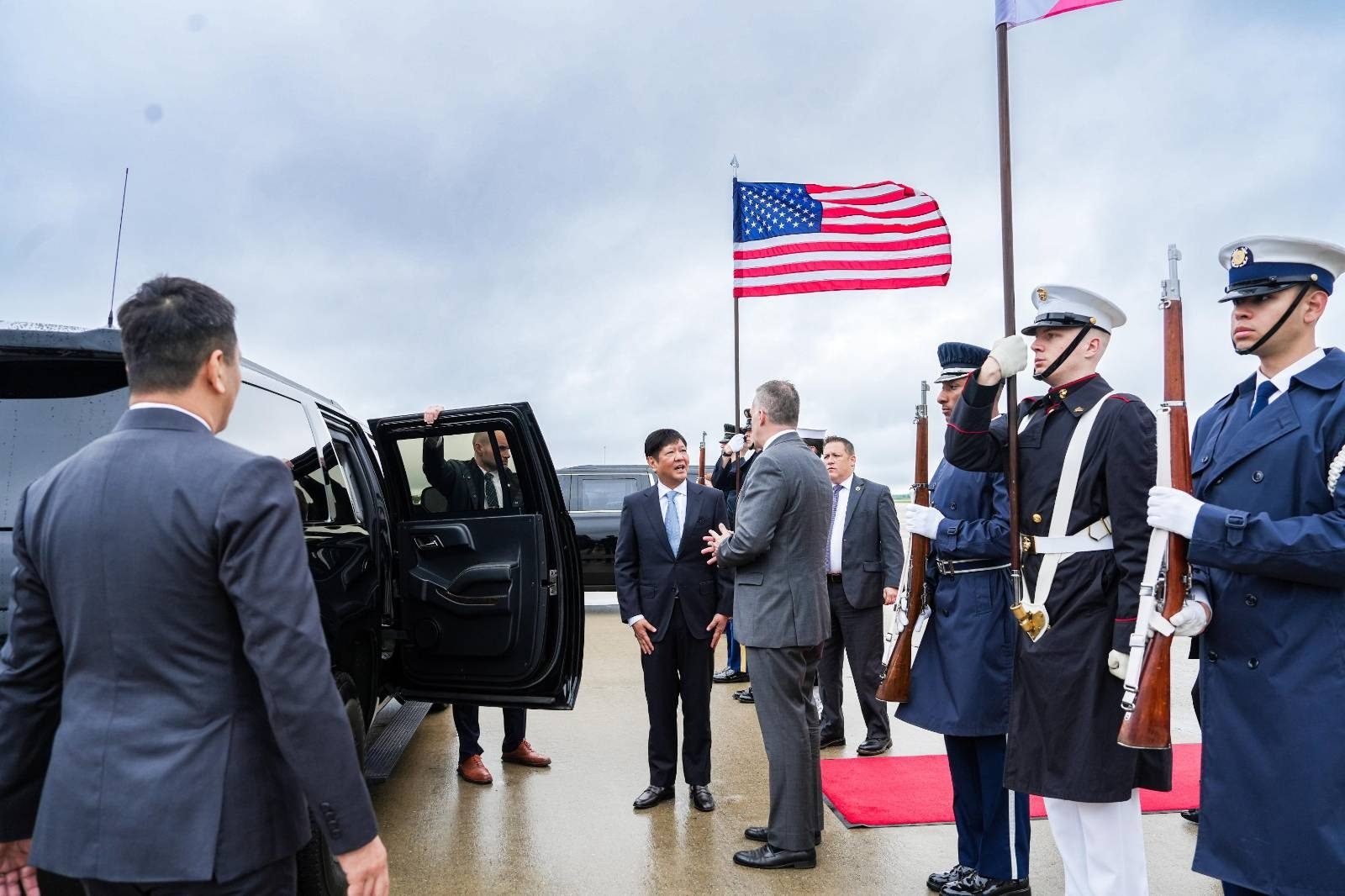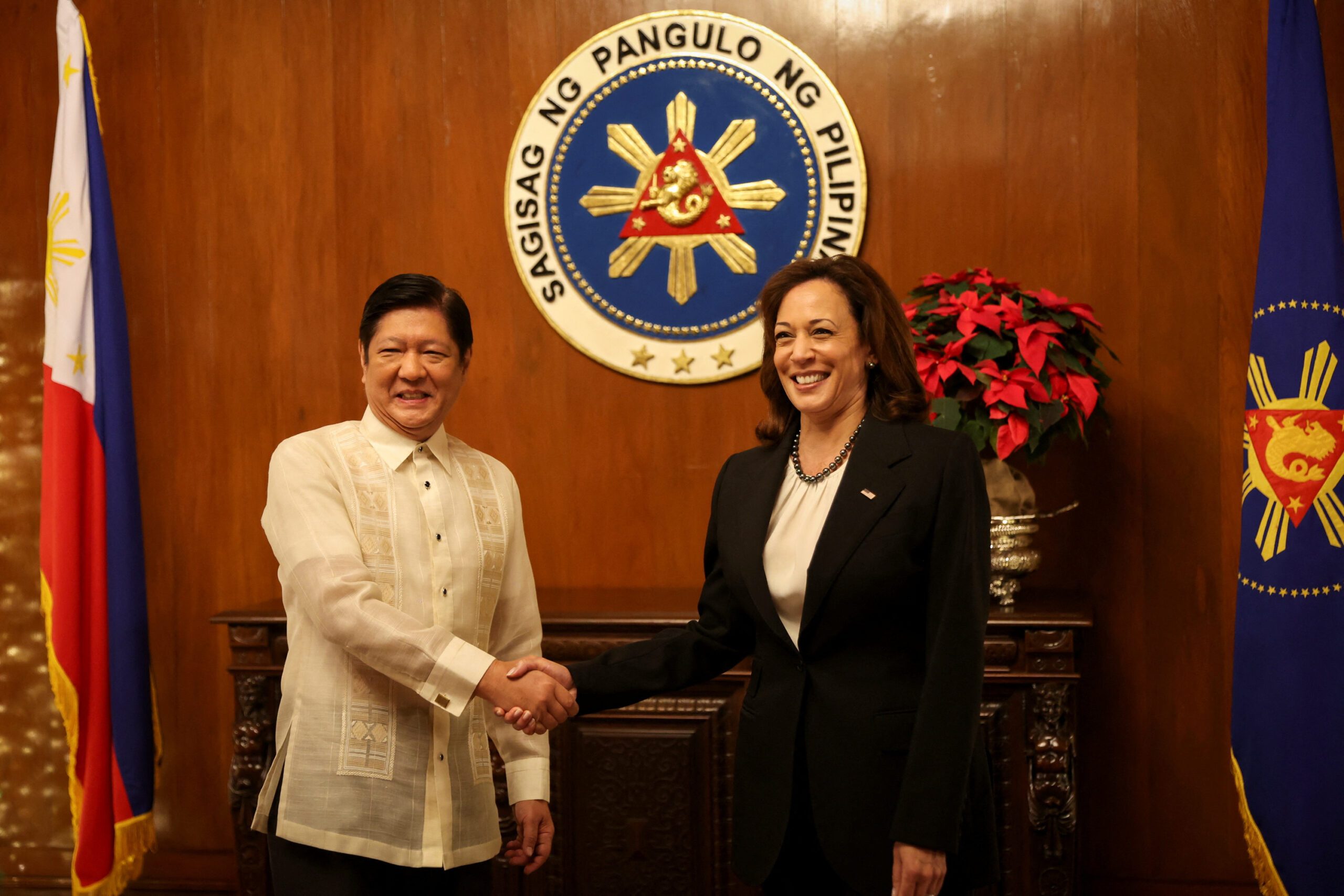SUMMARY
This is AI generated summarization, which may have errors. For context, always refer to the full article.

WASHINGTON DC, USA – Manila’s pivot back to Washington reaches its climax on Monday, May 1, as a Filipino president steps inside the White House for the first time in over a decade.
Philippine President Ferdinand Marcos Jr. is set to meet US President Joe Biden at the White House on Monday (Tuesday, May 2, in Manila), a symbolic move in the face of China’s efforts to lure Southeast Asia away from America.
By making this visit, Marcos follows in the footsteps of the late Benigno Aquino III, the last Filipino president to meet his American counterpart at the White House. Marcos’ trip to the US goes a notch higher, in fact, as Marcos is undertaking an official visit, as opposed to Aquino’s lower-level working trip in 2012.
Coupled with moves such as approving four new bases under EDCA, personally witnessing Balikatan, and summoning the Chinese ambassador to Malacañang, Marcos is taking a path closer to Aquino’s than Duterte’s when it comes to the US and China.
“My visit to the United States, and more especially my meeting with President Joe Biden, is essential to advancing our national interests and strengthening that very important alliance,” said Marcos in a speech at Villamor Airbase before boarding the presidential plane PR001.
Just eight months before this, Marcos also declared in New York City that he could not “see the Philippines in the future without having the United States as a partner.”
For a president who ran on a platform of continuity, this is a departure from his predecessor, Duterte, who vowed never to visit America as president, called Barack Obama a son of a whore, and declared in Beijing “my separation from the United States, both in military but economics also.”
Friends, partners, allies, and the South China Sea
This is the second time Marcos and Biden are meeting. The first time was in New York on the sidelines of the United Nations General Assembly in September 2022.
If the first meeting in New York was about introductions and making connections, the second one is about making sense of those ties.
Marcos said he wants to hear from Biden himself where the US stands given tensions in region. The Philippine president, who is joined in this trip by his defense officials, said he also wants the Philippine position of “peace” clear to its longtime ally.
Ambassador Teresita Daza, spokesperson of the Philippine Department of Foreign Affairs, said in an April 29 briefing that “discussions on security and defense are a given.” For this particular trip, she added, “there will be a heavy emphasis on the economic agenda.”
It is, however, impossible to leave China out of the equation. Marcos entered Malacañang just as competition between Washington and China in the Indo-Pacific heightens.
The Philippines, among the US’s oldest treaty allies, is right in the middle of this competition, made more tense by China’s brazen acts in the West Philippine Sea, a portion of the South China Sea that’s part of the Philippines’ exclusive economic zone.
The Aquino administration made a successful push to set back China’s claim of practically the entire South China Sea. Beijing, however, has refused to acknowledge the ruling.
Philippine-China relations then took a 180-degree turn during Duterte’s failed “pivot” to China.

Several key officials of the Biden administration have visited Marcos in Malacañang, the most prominent of whom are US Vice President Kamala Harris, US Secretary of State Antony Blinken, and US Defense Secretary Lloyd Austin. The Philippines and the US’ foreign affairs and defense ministers also recently met for a 2 + 2 Ministerial Meeting.
At the same time, Marcos has made it a point to keep China, its largest trading partner, close. He promised a “maturing” of Philippine-China relations during a state visit to Beijing in January 2023, then summoned Chinese Ambassador to Manila Huang Xilian months later, after a laser-pointing incident in the West Philippine Sea.
Months later, Marcos came to Huang’s defense after the Chinese envoy criticized the addition of four military bases under Manila and Washington’s Enhanced Defense Cooperation Agreement (EDCA) and advised the Philippines to stand against Taiwan independence if it “[cares] genuinely” about Filipino migrant workers in Taiwan.
Marcos recently welcomed to Malacañang Chinese Foreign Minister Qin Gang even as the Philippine government, through the Philippine Coast Guard, has become more vocal about China’s harassment in the West Philippine Sea.
In an interview en route to Joint Base Andrews for the US visit, Marcos called on China to fulfill an earlier obligation to a communications mechanism that would help avoid “miscalculations” in these waters.
There is a limit, too, to Marcos’ and the Philippines’ willingness to take sides in the Sino-American competition. “We work for peace. We’ll not encourage any provocative action by any country that involves [the Philippines]. We will not allow that to happen. We will not use – we will not allow the Philippines to be used as a staging post for any kind of military action,” said Marcos.
Defense commitments, economic ties
The Philippines is among the US’s oldest treaty allies, which means both countries have vowed to come to each other’s defense in the event of an attack. Harris, during a visit in November 2022, affirmed the US’s commitment to defending the Philippines from an attack in the South China Sea.
It also means that Manila is a key part of the US’ strategy in the Indo-Pacific.
“For the United States, the Philippines is an indispensable ally due its strategic location, just south of Taiwan and abutting the South China Sea. Whether the United States has access to military facilities in the Philippines could potentially be the key variable in a military contingency in the Western Pacific,” said Brian Harding, senior expert for Southeast Asia and Pacific Islands at the United States Institute of Peace.
Manila also stands to benefit from the military alliance, especially given China’s transgressions. “While the Philippines would prefer to be able to deter China unilaterally and is seeking to develop a more credible defense posture for itself, the reality is its greatest asset is the security guarantee under the Mutual Defense Treaty (MDT) with the United States and US commitment to abide by the treaty,” he said.
Marcos has said that he wants the MDT to “evolve” according to changes in geopolitics: the situation in the South China Sea, Taiwan, and North Korea, among others.

“The conditions under which the Mutual Defense Treaty was written, the original one, are completely different from the conditions we’re facing now. China, of course, has become very dominant in the region. The United States has become less so. But then the other player, i.e. like ASEAN member-states, all the Asian states have also changed their position in the world…. We will talk about all of these things. So that’s really one of the main purposes of the visit,” he told the media in an interview on board the presidential plane.
The Marcos before him
There is certainly also personal history at play when you talk about the Marcos clan and the United States.
Marcos’ father and namesake, the dictator Ferdinand E. Marcos Sr., had a very close relationship with the Americans then. Despite rampant human rights abuses in the Philippines, Washington remained a very close friend and ally to the elder Marcos, until it could not.
Even when the US finally withdrew support for Marcos Sr., it was the Americans who helped the Marcos clan – the current President included – flee Malacañang for what would eventually become exile in Hawaii.
Thus it’s in the US, too, where Marcos and his family faced cases over their theft of Philippine funds and human right abuses. Marcos Jr. and his mother, the former first lady Imelda Marcos, have standing contempt judgements against them in the US. But as chief executive, Marcos enjoys and has been promised diplomatic immunity.
Exile in Hawaii did not last that long, however. In 1992, not even a decade since they were ousted from Malacañang during the People Power Revolution, Marcos Jr. returned to the Philippines and ran for office as a matter of “survival” for his clan.
The priority of the Marcoses, according to analysts, is to clean their family’s name on the world stage.
Fast-forward to May 2022, Biden was the first to congratulate Marcos when it was clear he would be the 17th president of the Republic.
Biden, as the Washington Post pointed out ahead of his meeting with Marcos, had opposed the President’s father in the 1980s.
Biden “suggested that President Ronald Reagan’s willingness to support the Philippine dictator was in part based on his desire to maintain US leases on military bases,” the Washington Post reported on Sunday, April 30.
“If we are totally identified with a corrupt, discredited regime that does not have the support of its people, we may be able to hold on to our bases in the short term but we will so alienate the people that we will lose them in the long run,” Biden, then a senator, reportedly said.
While the Marcos dictatorship is not expected to be discussed, the White House said in a statement that human rights would be on the agenda in the meeting with Marcos, consistent with the Biden administration’s strategy on the Indo-Pacific. Malacanang did not include human rights or press freedom in its agenda.
During their meeting, Marcos and Biden will also agree to new guidelines aimed at strengthening military cooperation, said US officials, underscoring a dramatic turnaround in US-Philippine relations over the past year.
Biden will also reaffirm the countries’ 1951 Mutual Defense Treaty, which calls for the United States to act in the event of an armed attack on the Philippine military, said the officials. – with reports from Reuters/Rappler.com
Add a comment
How does this make you feel?



![[Just Saying] SONA 2024: Some disturbing points](https://www.rappler.com/tachyon/2024/07/TL-marcos-sona-points-july-23-2024.jpg?resize=257%2C257&crop=335px%2C0px%2C720px%2C720px)






There are no comments yet. Add your comment to start the conversation.